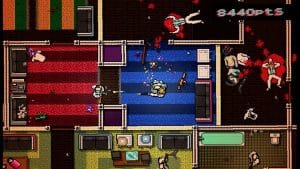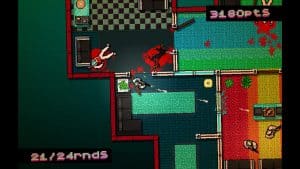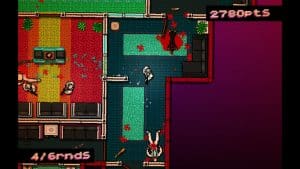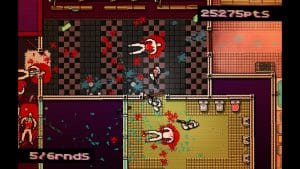Hotline Miami
Related Games
Description
🔥 What is Hotline Miami for PC?
Hotline Miami is a brutal top-down action game developed by Dennaton Games and published by Devolver Digital, first released in 2012. Set in a neon-soaked version of late-1980s Miami, the game throws players into a feverish blend of ultraviolence, surreal storytelling, and pounding electronic music that defines its hypnotic atmosphere. You play as a nameless, silent protagonist often referred to by fans as “Jacket” who receives mysterious phone calls instructing him to carry out assassinations against various criminal groups across the city.
Each mission is a fast-paced puzzle of violence where you must clear buildings filled with armed enemies using whatever tools and weapons you can find. Beneath its blood-soaked surface, however, lies an unsettling psychological story about identity, morality, and the blurred line between reality and hallucination. Hotline Miami is not just an arcade shooter it’s an experience that questions the nature of violence in video games and the people who consume them.
The game’s stylistic fusion of pixel art, synthwave aesthetics, and fragmented storytelling helped it achieve cult status almost instantly. Its distinctive mix of retro visuals, experimental sound design, and relentless pace has made it one of the most influential indie games of the 2010s, inspiring countless successors that try to replicate its strange magic.
👉 Features of Hotline Miami
Hyper-Violent Combat System
Hotline Miami offers lightning-fast, unforgiving combat where every action can mean life or death. Enemies die in a single hit, but so do you, forcing players to approach each room like a tactical puzzle rather than a chaotic shootout. You can bash heads, throw weapons, fire shotguns, or strangle enemies with your bare hands all animated with startling intensity for a pixelated game.
The emphasis on speed and precision creates a uniquely rhythmic flow. You often restart levels dozens of times, internalizing enemy patterns until your movements become an instinctive dance of violence. The system rewards aggression but punishes recklessness, keeping players constantly on edge and fully immersed.
Mask System and Player Customization
Before each mission, players can choose from a set of animal masks that grant different gameplay bonuses, such as faster movement, quieter footsteps, or starting with a specific weapon. Each mask subtly changes your approach, making replaying levels both strategic and deeply personal.
Some masks also reflect aspects of the protagonist’s fractured psyche, hinting at the deeper psychological narrative. This system adds variety, encouraging experimentation while reinforcing the game’s surreal tone.
Retro Aesthetic and Synthwave Soundtrack
Hotline Miami’s visual style is both nostalgic and overwhelming, using saturated neon colors, distorted effects, and pulsing lights to evoke a sense of mania. The environments bleed with reds and oranges, capturing the intensity of both the 1980s aesthetic and the protagonist’s deteriorating mind.
The soundtrack, composed by a lineup of artists including Perturbator, M.O.O.N., and Carpenter Brut, is a crucial part of the experience. Its pulsating electronic beats sync with the gameplay’s pace, driving adrenaline to absurd levels while simultaneously giving each stage its own identity.
Fragmented Narrative and Psychological Mystery
The story unfolds through disjointed sequences, unreliable narration, and surreal dreamlike scenes. Between missions, players witness snippets of the protagonist’s daily life, cryptic visions, and disturbing encounters with masked figures who question his morality and sanity.
This storytelling method invites interpretation rather than providing clear answers. Players are left to piece together the truth about who they are, why they kill, and whether any of it is real. It’s a narrative that thrives on ambiguity, rewarding those who look beyond the bloodshed.
Replayability and Score System
Each mission is graded based on your speed, combo chains, and overall style, motivating you to replay for higher scores. The scoring encourages reckless creativity experimenting with different weapons or using environmental kills boosts your rank.
This mechanic adds a layer of arcade competitiveness to the otherwise grim tone, creating a strange duality: players chase perfection in a world built on chaos. It’s both addictive and disquieting.
Gameplay
Fast, Brutal, and Addictive Combat
At its core, Hotline Miami is about mastering violent rhythm. Every level plays out as a compact, self-contained puzzle of destruction, where observation, reaction time, and memory all intertwine. You must plan your entry, predict enemy movement, and execute without hesitation.
Failure comes quickly but never feels discouraging. Restarting is instantaneous, and the urge to perfect each run becomes irresistible. Over time, the game subtly conditions you into craving that perfect kill flow a feeling both exhilarating and morally unsettling.
Weapons, Enemies, and Level Design
Weapons range from melee tools like bats and knives to firearms such as pistols and assault rifles. Each weapon feels distinct, forcing you to adapt to its range and timing. Enemies are deadly accurate, so stealth and timing matter more than brute force.
Levels are designed to encourage experimentation. Doors can be used as weapons, and walls obscure line of sight, making spatial awareness essential. Every level feels handcrafted to test different instincts patience, aggression, or clever improvisation.
Story Progression and Meta Elements
Between missions, the tone shifts completely. Jacket returns home to his filthy apartment, interacts with strange NPCs, and experiences increasingly surreal hallucinations. These segments slow the pace and reveal fragments of the truth, transforming the game from a simple shooter into a psychological descent.
Later, players encounter multiple perspectives and overlapping timelines that challenge their assumptions. The narrative doesn’t just accompany the gameplay it recontextualizes it, forcing players to reflect on their own participation in the violence.
Graphics
Neon-Fueled Pixel Art
Hotline Miami’s pixel art aesthetic deliberately contrasts its brutal subject matter. The environments are vibrant, colorful, and stylish, yet splattered with grotesque violence that stains every room. This combination creates visual dissonance that’s both beautiful and disturbing.
Lighting effects and exaggerated color palettes evoke the feverish atmosphere of a drug-induced dream. The perspective is slightly skewed, enhancing the surreal sense that something is always off balance. It’s not realism the game seeks, but intensity.
Visual Effects and Atmosphere
The camera shakes, colors blur, and the screen pulses when you die or execute a kill streak, amplifying the chaos. Blood sprays in thick, painterly strokes, and bodies pile up in grotesque tableaux that remain visible even after completing a stage.
These stylistic touches are not just decoration they reinforce the protagonist’s mental instability. The more you play, the more the visuals seem to distort reality, mirroring the game’s descent into madness.
Character and Environment Design
Enemies may look simple, but their behavior and positioning make them feel dangerously intelligent. Each level’s design feels alive, with furniture placement, narrow corridors, and glass walls influencing tactics.
Background details, such as flickering televisions or ominous graffiti, enrich the setting with silent storytelling. Even the protagonist’s masks and costumes tell unspoken tales of identity and guilt.
Pros and Cons
✔️ Pros
- Incredible Soundtrack: The pulsating synthwave score perfectly matches the gameplay’s intensity and atmosphere.
- Addictive Gameplay Loop: Instant restarts and precise controls make failure feel motivating rather than punishing.
- Stylish Visual Identity: The neon-soaked pixel art and surreal presentation create one of the most recognizable aesthetics in gaming.
- Psychological Storytelling: A haunting and ambiguous narrative that invites deep analysis and interpretation.
- Replay Value: High score systems and mask bonuses encourage replaying every mission for mastery.
❌ Cons
- Extremely Difficult: The one-hit-death system can frustrate players not used to trial-and-error gameplay.
- Abstract Storytelling: Some players may find the plot too cryptic or fragmented to follow.
- Short Length: The campaign can be completed in a few hours, though replay value extends its lifespan.
- Graphic Violence: The unflinching brutality may alienate players uncomfortable with excessive gore.
Images










